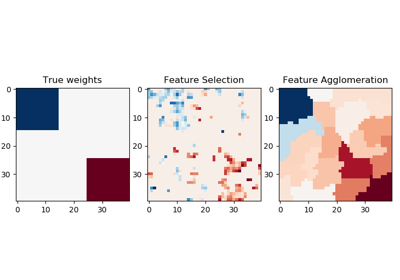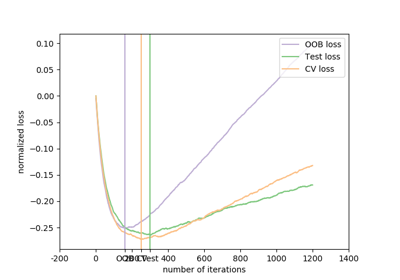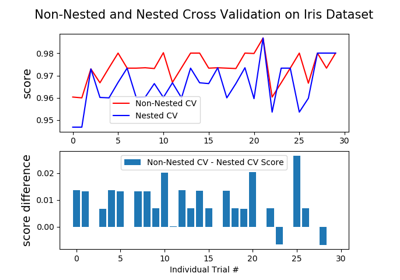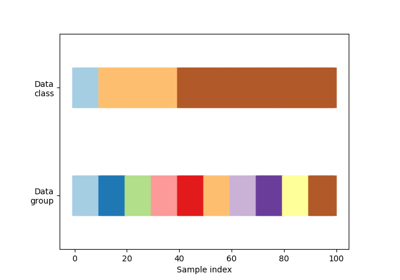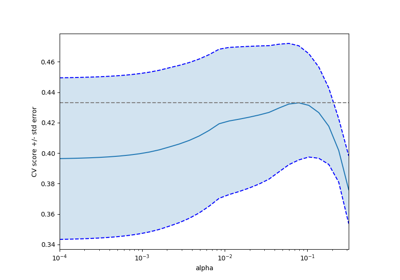sklearn.model_selection.KFold¶
-
class
sklearn.model_selection.KFold(n_splits=5, shuffle=False, random_state=None)[source]¶ K-Folds cross-validator
Provides train/test indices to split data in train/test sets. Split dataset into k consecutive folds (without shuffling by default).
Each fold is then used once as a validation while the k - 1 remaining folds form the training set.
Read more in the User Guide.
- Parameters
- n_splitsint, default=5
Number of folds. Must be at least 2.
Changed in version 0.22:
n_splitsdefault value changed from 3 to 5.- shuffleboolean, optional
Whether to shuffle the data before splitting into batches.
- random_stateint, RandomState instance or None, optional, default=None
If int, random_state is the seed used by the random number generator; If RandomState instance, random_state is the random number generator; If None, the random number generator is the RandomState instance used by
np.random. Only used whenshuffleis True. This should be left to None ifshuffleis False.
See also
StratifiedKFoldTakes group information into account to avoid building folds with imbalanced class distributions (for binary or multiclass classification tasks).
GroupKFoldK-fold iterator variant with non-overlapping groups.
RepeatedKFoldRepeats K-Fold n times.
Notes
The first
n_samples % n_splitsfolds have sizen_samples // n_splits + 1, other folds have sizen_samples // n_splits, wheren_samplesis the number of samples.Randomized CV splitters may return different results for each call of split. You can make the results identical by setting
random_stateto an integer.Examples
>>> import numpy as np >>> from sklearn.model_selection import KFold >>> X = np.array([[1, 2], [3, 4], [1, 2], [3, 4]]) >>> y = np.array([1, 2, 3, 4]) >>> kf = KFold(n_splits=2) >>> kf.get_n_splits(X) 2 >>> print(kf) KFold(n_splits=2, random_state=None, shuffle=False) >>> for train_index, test_index in kf.split(X): ... print("TRAIN:", train_index, "TEST:", test_index) ... X_train, X_test = X[train_index], X[test_index] ... y_train, y_test = y[train_index], y[test_index] TRAIN: [2 3] TEST: [0 1] TRAIN: [0 1] TEST: [2 3]
Methods
get_n_splits(self[, X, y, groups])Returns the number of splitting iterations in the cross-validator
split(self, X[, y, groups])Generate indices to split data into training and test set.
-
__init__(self, n_splits=5, shuffle=False, random_state=None)[source]¶ Initialize self. See help(type(self)) for accurate signature.
-
get_n_splits(self, X=None, y=None, groups=None)[source]¶ Returns the number of splitting iterations in the cross-validator
- Parameters
- Xobject
Always ignored, exists for compatibility.
- yobject
Always ignored, exists for compatibility.
- groupsobject
Always ignored, exists for compatibility.
- Returns
- n_splitsint
Returns the number of splitting iterations in the cross-validator.
-
split(self, X, y=None, groups=None)[source]¶ Generate indices to split data into training and test set.
- Parameters
- Xarray-like, shape (n_samples, n_features)
Training data, where n_samples is the number of samples and n_features is the number of features.
- yarray-like, shape (n_samples,)
The target variable for supervised learning problems.
- groupsarray-like, with shape (n_samples,), optional
Group labels for the samples used while splitting the dataset into train/test set.
- Yields
- trainndarray
The training set indices for that split.
- testndarray
The testing set indices for that split.

